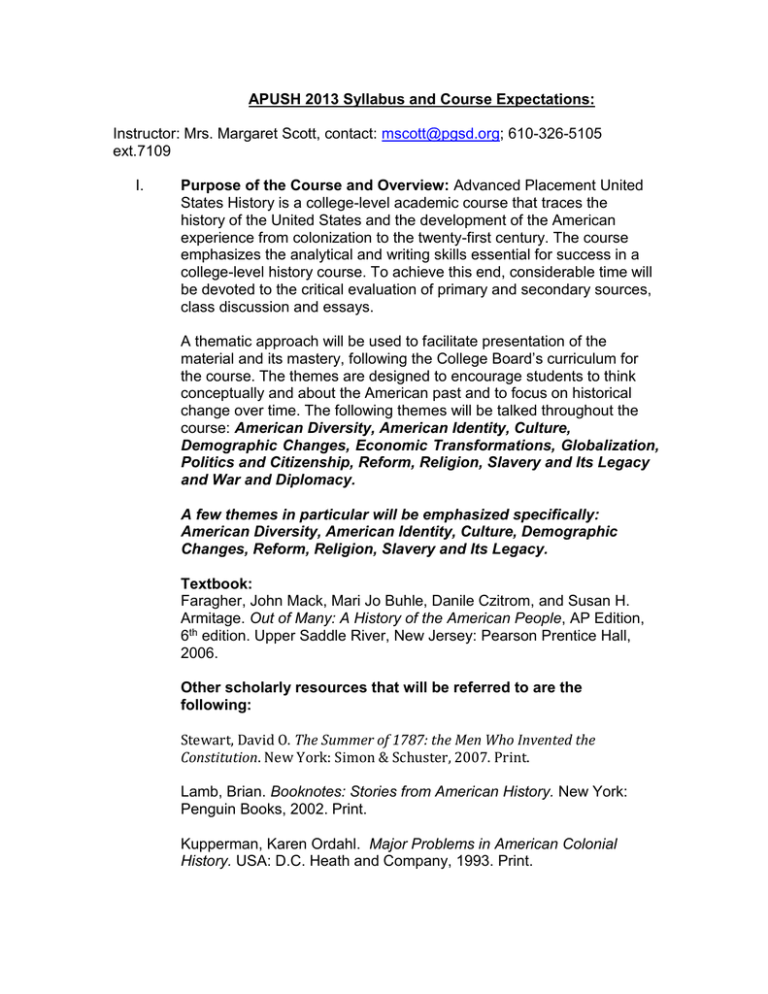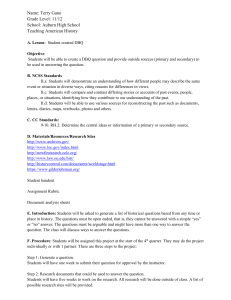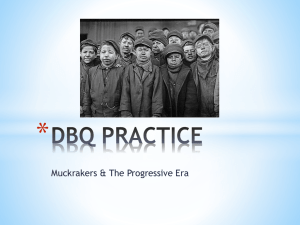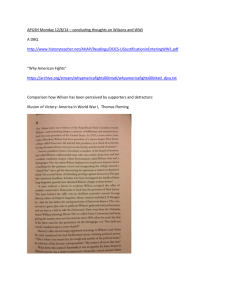
APUSH 2013 Syllabus and Course Expectations:
Instructor: Mrs. Margaret Scott, contact: mscott@pgsd.org; 610-326-5105
ext.7109
I.
Purpose of the Course and Overview: Advanced Placement United
States History is a college-level academic course that traces the
history of the United States and the development of the American
experience from colonization to the twenty-first century. The course
emphasizes the analytical and writing skills essential for success in a
college-level history course. To achieve this end, considerable time will
be devoted to the critical evaluation of primary and secondary sources,
class discussion and essays.
A thematic approach will be used to facilitate presentation of the
material and its mastery, following the College Board’s curriculum for
the course. The themes are designed to encourage students to think
conceptually and about the American past and to focus on historical
change over time. The following themes will be talked throughout the
course: American Diversity, American Identity, Culture,
Demographic Changes, Economic Transformations, Globalization,
Politics and Citizenship, Reform, Religion, Slavery and Its Legacy
and War and Diplomacy.
A few themes in particular will be emphasized specifically:
American Diversity, American Identity, Culture, Demographic
Changes, Reform, Religion, Slavery and Its Legacy.
Textbook:
Faragher, John Mack, Mari Jo Buhle, Danile Czitrom, and Susan H.
Armitage. Out of Many: A History of the American People, AP Edition,
6th edition. Upper Saddle River, New Jersey: Pearson Prentice Hall,
2006.
Other scholarly resources that will be referred to are the
following:
Stewart, David O. The Summer of 1787: the Men Who Invented the
Constitution. New York: Simon & Schuster, 2007. Print.
Lamb, Brian. Booknotes: Stories from American History. New York:
Penguin Books, 2002. Print.
Kupperman, Karen Ordahl. Major Problems in American Colonial
History. USA: D.C. Heath and Company, 1993. Print.
Zinn, Howard. People’s History of the United States. USA:
HarperCollins, 2010. Print.
II.
Assessment and Grading Scale:
Student achievement in the class will be assessed in four areas
Exams……………………………….30%
Quizzes………………………………20%
DBQ and Free Response Essays…30%
Classwork…………………………….10%
Homework…………………………….10%
Exams will consist of multiple-choice questions formatted similar to
those on the AP exam. Some exams will be cumulative meaning
previous material could be seen again. This is designed to reinforce
material and facilitate the discovery of connections and comparisons
with the content.
Being able to analyze documents and develop a logical written
argument is a skill essential for success on the AP exam but also in
college. Topics for our assigned DBQ and free response essays will
follow the AP format and emphasize material addressed in class. The
AP grading rubric will be used to evaluate each piece of writing for the
Document-Based Question and Free Response.
III.
AP Examination Date: The date for the 2014 AP US History exam
has not been set. *It is our expectation though that our AP
students seriously consider taking the exam and those who
question whether or not this has value for them are encouraged
to speak with their guidance counselor.
I am interested in setting up a practice exam simulation for interested
students prior to the actual exam. We plan to offer two or three dates after
school and Saturday morning in which students who would like to
participate in a practice run through of a 3 hour and 5 minute exam module
could do so. We will be giving multiple-choice questions and DBQ and Free
Response questions that were seen on actual recent exams. These will be
scored and returned to the student days in advance of their actual test in
order to ease fears and give experience with the layout.
IV.
Classroom Rules and Attendance:
1. The textbook, notebook and pen or pencil must be brought daily. Success
in AP depends in part of the student’s self-discipline and work ethic. Good
attendance is crucial! Being prepped for class, taking notes and
2.
3.
4.
5.
V.
contributing to the discussion are explicit expressions of those essential
characteristics. It is also an expression of respect for the class, the subject
and the instructor.
Make-up tests are to be taken AFTER-SCHOOL or during a STUDY HALL.
Cheating of any kind will not be tolerated- see handbook for plagiarism
consequences.
No eating or drinking in class is allowed with the exception of water bottles.
You may not leave the room except for emergencies. Please use the
restrooms during class change.
Homework and Articles Assignment:
There will RARELY be a day when the student does not have homework in
AP U.S. Expect daily reading assignments, taking notes or reviewing class
materials. Reading assignments by unit will be broken out in advance and
given in handout form or posted on the teacher’s wiki page.
VI.
Course Organization: The organization of our course by instructional
topic reflects the design provided by the College Board.
Week One: Course Introduction, APUSH strategies and organizers, DBQ and
Free Response exposure and brief discussion of Pre-Columbian society.
Students should plan on reading chapter one August 27-September 3.
We will introduce the APPARTS and OPTIC Strategies this week. We will also
use a past DBQ on Nixon to show how their strategies could be used to help
them in a document based question scenario. We will show the students how to
construct their thesis and what the five-paragraph essay entails. They will read
actual submissions and grade them before being presented with the official
scores per AP Central. We will show the classes how Mr. Hawthorne and Mrs.
Scott would have handled the thesis-writing component and where and when
they would have employed the sources if actually submitting the DBQ. The class
will develop the content material that could have been used as background
knowledge to strengthen the essay. Students will be presented with the huge list
of appropriate content that could be included for credit. We will then work to
develop a strong conclusion as a class to the DBQ prompt that was provided on
Richard Nixon. This provides the model for serious analytical writing that the
students will be asked to do in class this year.
Period Two: 1491- 1607 Transatlantic Encounters and Colonialism (7 days)
The diversity of this period will be referenced through discussion about the
motivation of English, French and Spanish colonization. We will also be
highlighting the treatment of native peoples and slaves in this period of change.
Some primary sources that will be utilized are the following: Las Casas Black
Legend, Equiano, and Hiawatha
The FRQ given in this unit is: “What important differences were there between
Indian societies in the Southwest, South and Northeast on the eve of
colonization.”
Period Three: 1607-1754 Colonial North America (14 days)
This unit will focus upon the diversity of settlement among the English and the
expansion of settlement in North America. Demographic change will be
addressed as African Americans replace indentured servants as a labor source.
Comparisons of southern, middle and northern colonies will be evaluated.
DBQ given asking students to address the differences between settlement in the
Chesapeake and New England. Students are asked to use the sources provided
to identify differences politically and socially in the two areas.
Primary sources that will utilized are the following: “Ann Putnam’s Deposition and
Confession”, “Mayflower Compact”, “William Penn’s Description of PA”, and “VA
Law on Indentured Servitude”
Period Four: 1754-1800 Revolutionary Era and the Establishment of a
Republic (17 days)
American Diversity will undergo challenge in this period as colonists are asked to
decide if they wish to remain loyal to the crown or become Americans. The
revolutionary conflict will embroil all “Americans” be they English citizens or not.
Causes and results of the war will be explored.
Primary sources that will be used are the following: “Albany Plan of the Union”,
“Join or Die “political cartoon, “Common Sense”, “Remember the Ladies” letter,
De Tocqueville’s “Democracy in America”, Paul Revere’s engraving, Townsend
Acts, Stamp Act and Intolerable Acts
Period Five: 1800-1848 Economic, Political and Societal Change in America
(14 days)
General Washington was a fine choice as a new executive and he set a strong
precedent for others to follow. This period will demonstrate a shift in American
policy toward dealing with Britain as well as a change in the type of president that
we required. The transition of power from Federalists to Republicans and the
federal government’s role in domestic and foreign policies will also be examined.
Primary Sources that will be used are the following: “Davy Crockett’s Advice to
Politicians”, “Washington’s Farewell Address”, “Jackson’s inaugural address”,
“Treaty of Ghent”, “Lewis and Clark meet the Shoshone”, “Star Spangled Banner”
Period Six: 1844-1865 Territorial Expansion Leads to Sectional Crisis (18
days)
Diversity and differences in culture are very clear in the tensions leading to
sectional crisis. Compromise between competing factions only bought time, it
didn’t address the main problem that we could not continue to live half free and
half slave. As territories requested statehood, the problem had to be addressed.
The causes and results of American settlers’ moving west will be evaluated and
the impact of the Mexican War examined.
Primary Sources that will be used are the following: “Emancipation Proclamation”,
“Gettysburg Address”, Olmstead “Freedmen to Master”, Lincoln-Douglas
Debates, Oliver Wendell Holmes “Old Ironsides”, “House Divided Speech”, parts
of Uncle Tom’s Cabin, Causes of Secession, Garrison’s position on John
Brown’s Raid
Period Seven 1865- 1898 Reconstruction and Post-War Developments (18
days)
Multiple reconstruction plans were introduced and those reflect the divergent
thinking of how severely the south should be punished for their secession. Freed
blacks will move to find economic opportunity stressing the north but also
opening up the west to growth. The significance of the influx of immigrants and
their impact on cities in America will be evaluated as well.
Primary Sources that will be used are the following: sharecropper contract,
“Mississippi Black codes”, Worse than slavery- Nast cartoon, Nast
cartoons on Boss Tweed, photo of Union Pacific and Central Pacific Link
Period Eight 1890-1945 The Emergence of America as a World Power (24
days)
Imperialism and world war will lead Americans to question whether global
expansion is a helpmate or hindrance to the “American Dream”. Ethnic diversity
will become more apparent during these big years of immigration. Domestic
reform sponsored by the Progressive Movement will be examined, as will
American attitudes toward involvement in WWI and WWII.
“Mahan’s interest in America as a Sea Power”, “Platt Amendment”, William
Jennings Bryant ‘s “Cross of Gold Speech”, “Treaty of Versailles,” Margaret
Sanger’s “1920 Declaration of Sentiments”, “The Hayseed”, excerpt from The
Jungle, “Migrant Mother” photo
Period Nine 1945-1980 Impact of the Cold War (21 days)
The short years between the end of WWII and the Korean War followed
immediately by Vietnam demonstrate conflicting sentiments in the United States.
Protests by Civil Rights protestors, students and workers effectivel shows the
diverse opinions held by the American people at this time in history. The role of
America as a world leader in the post-WWII world will be evaluated. Domestic
programs and foreign policies of the Kennedy, Johnson and Nixon
administrations will be reviewed.
“Marshall Plan”, “Truman Doctrine”, “1965 Voting Rights Act”, excerpt from
“Feminine Mystique”, Joseph Welch’s McCarthy letter, Dewey Defeats Truman
misprint, “Iron Curtain” speech, Lyrics of “Strange Fruit”, “Letters from a
Birmingham Jail”, My Lai testimony, Roe v. Wade verdict, “Brown v. Board of
Education”
Period 10 1980-Present The US in the Post-War World (7 days)
Students will characterize society under Ronald Reagan and George H. Bush’s
administrations. Clinton and George W. Bush’s domestic and foreign policies will
be discussed as will issues that the United States is currently facing. Human
rights, globalization and societal change are themes integral to this unit.
“No Child Left Behind”, Clinton’s Impeachment Trial transcripts, Patriot Act,
NAFTA, SU Collapse news release
This allows for approximately 2 weeks of review before the AP exam. The
schedule found above is tentative and may be tweaked or changed a bit to
allow for course disruptions, weather interruptions, ect. All efforts will be
made to give students maximum notice if changes need to be made.
I am available for help:




